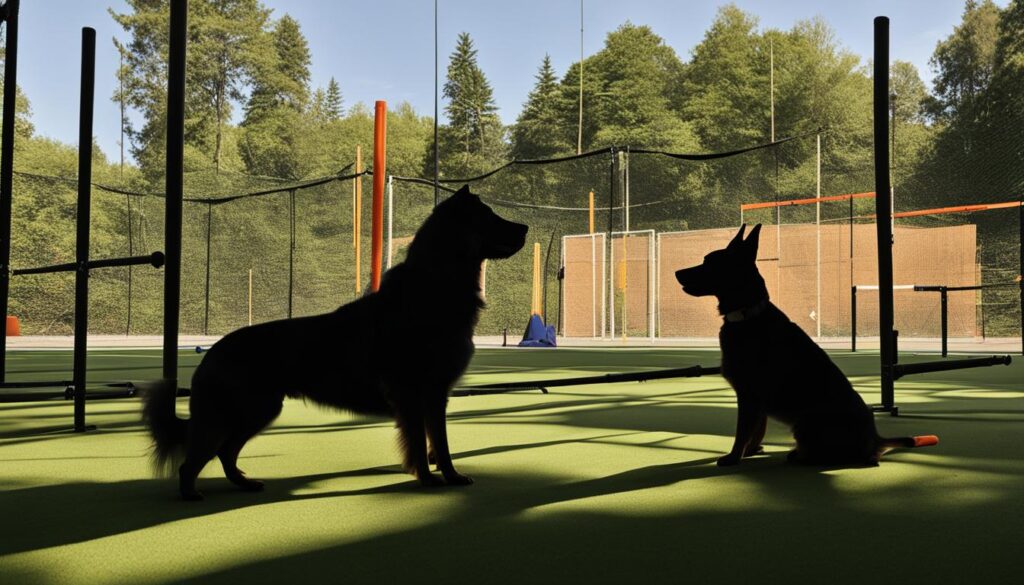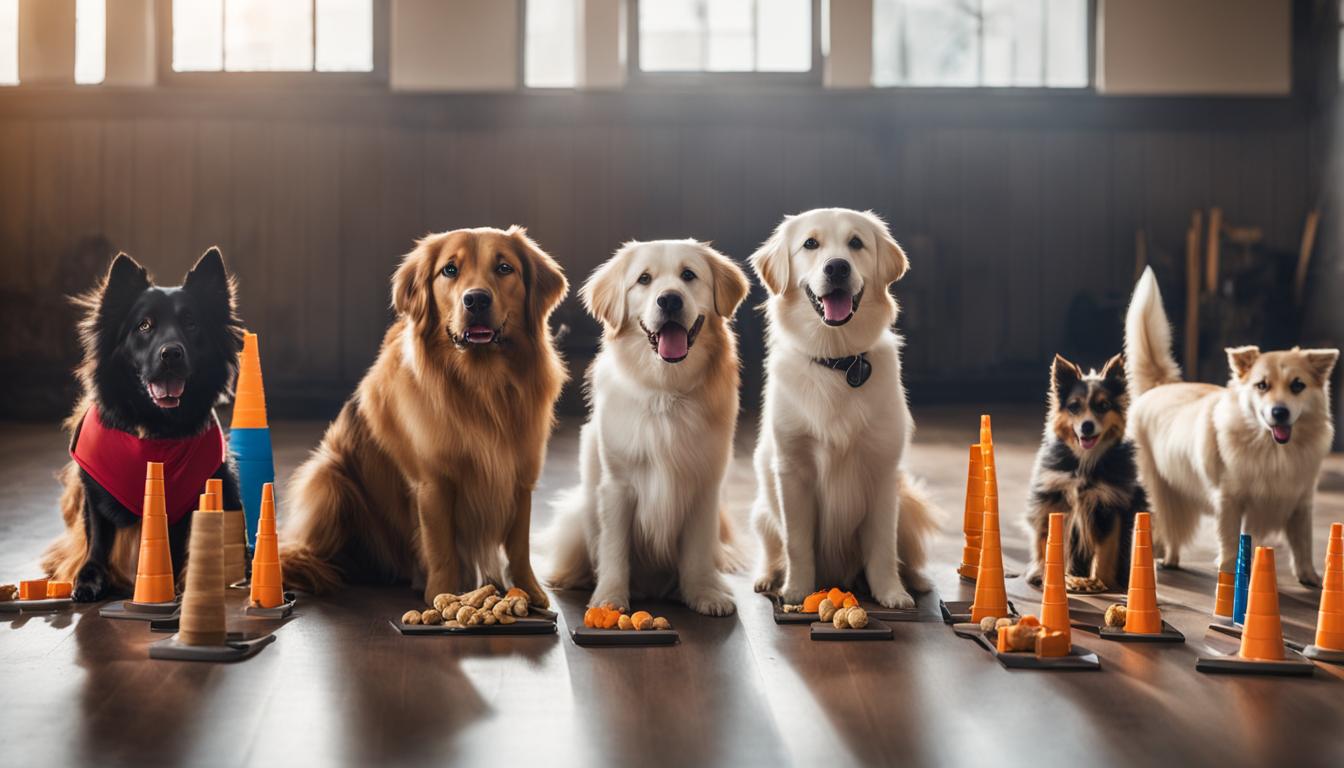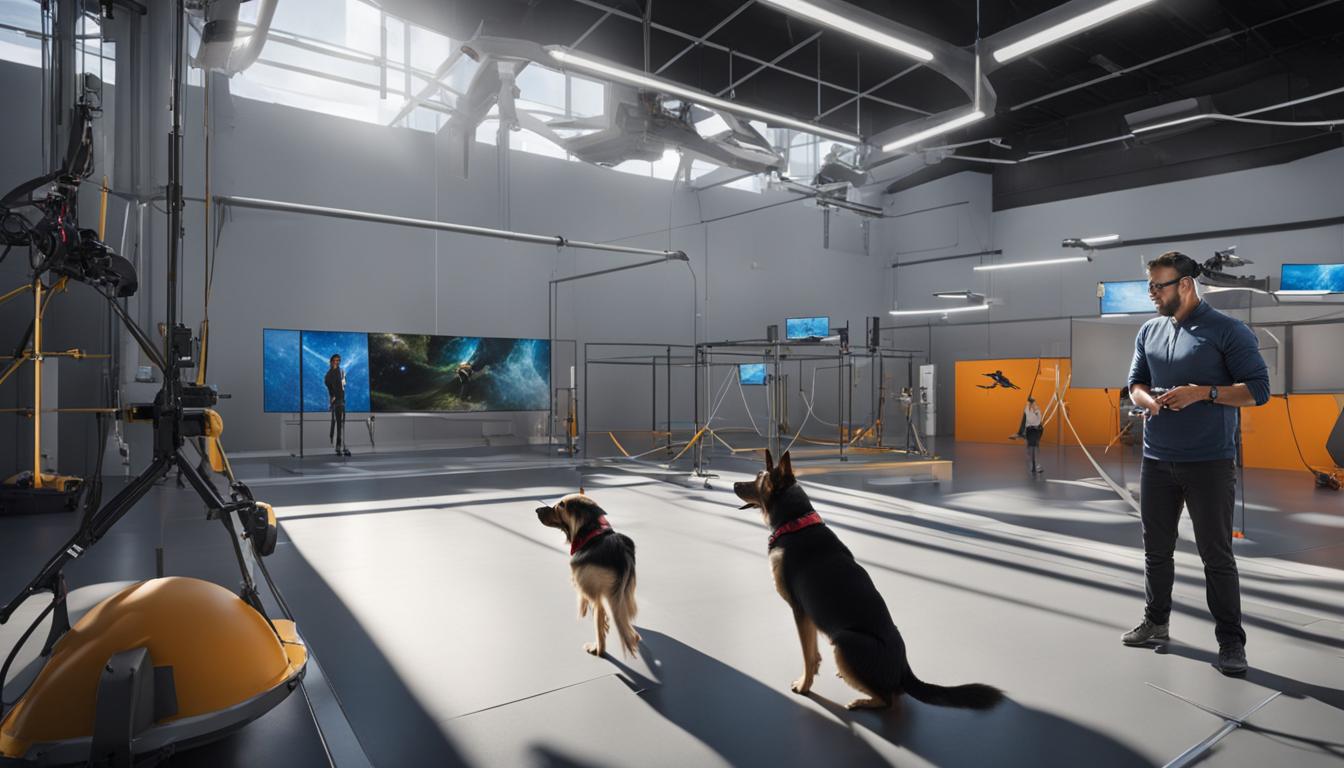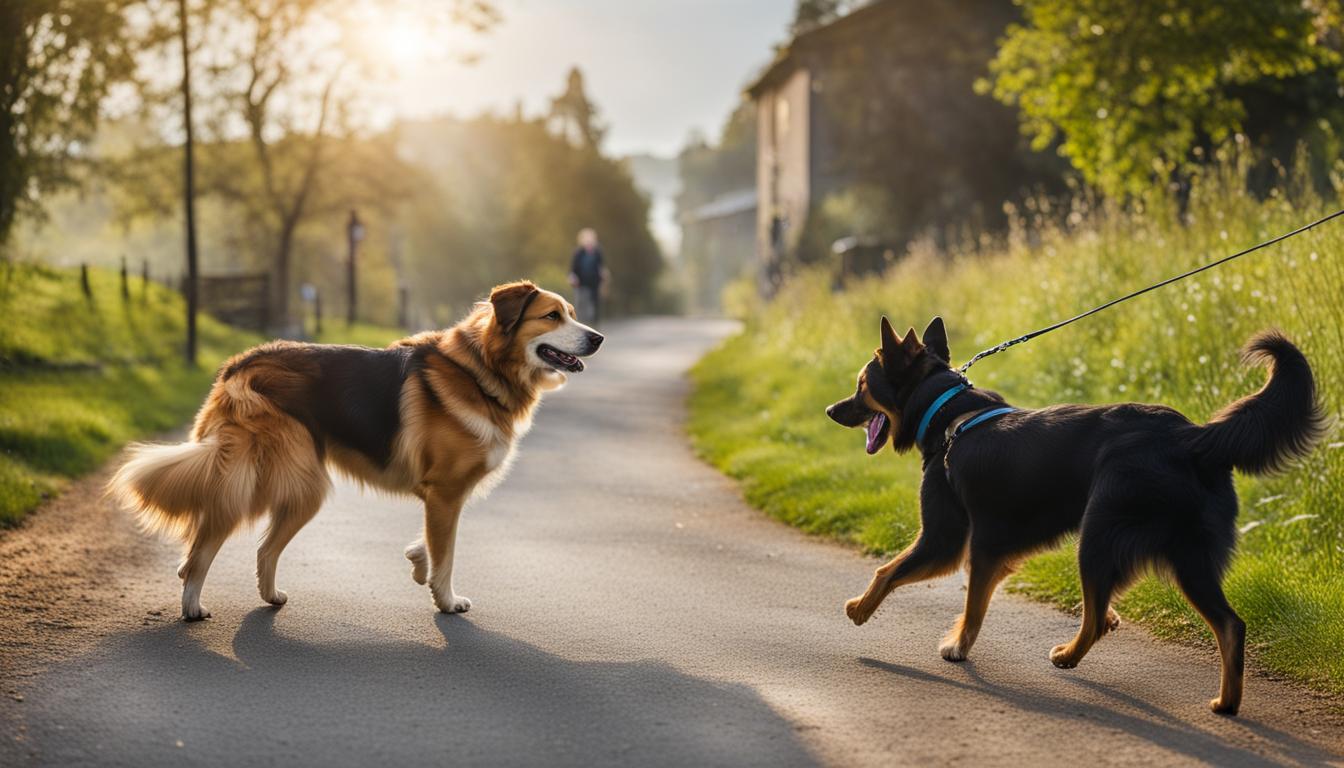Owning multiple dogs can be a rewarding experience, but it also comes with its own set of challenges. It’s important to consider factors such as cost, time commitment, supervision, and consistency when training multiple dogs.
The cost of owning multiple dogs can be significant, with expenses including food, toys, treats, training, and veterinary care. Time management is another challenge as each dog needs individual attention, playtime, and training. Supervision is crucial to ensure the safety of all dogs, especially when there are differences in size and energy levels. Consistency in training and routines is key to maintaining harmony in a multi-dog household.
Key Takeaways:
- Training multiple dogs requires careful consideration of cost, time commitment, supervision, and consistency.
- The financial implications of owning multiple dogs should be assessed before committing to training them.
- Time management is important to provide individual attention and training for each dog.
- Supervision and safety considerations are vital when training multiple dogs, especially when there are differences in size and energy levels.
- Consistency in training practices and routines helps maintain harmony in a multi-dog household.
The Financial Considerations of Training Multiple Dogs
Training multiple dogs can be a fulfilling experience, but it’s important to consider the financial implications. Owning multiple dogs comes with additional costs, such as food, toys, treats, training, and veterinary care. These expenses can add up quickly, especially for larger breeds or dogs with specific dietary or medical needs. To ensure that you can provide for all your dogs’ needs, it’s essential to develop a financial plan.
Start by assessing your current budget and determining how much you can comfortably allocate to your dogs’ care. Consider factors such as the cost of high-quality dog food, regular veterinary check-ups, vaccines, preventative medications, grooming, and training. Additionally, it’s a good idea to set aside a separate emergency fund for unexpected medical expenses or accidents.
Another important consideration is pet health insurance. While it may seem like an additional expense, it can provide peace of mind and significantly reduce unexpected out-of-pocket costs. Research different insurance plans to find one that suits your needs and budget, taking into account factors such as deductibles, coverage limits, and exclusions.
| Expense | Estimated Monthly Cost |
|---|---|
| Food | $50 – $100 |
| Veterinary Care | $50 – $100 |
| Training | $50 – $100 |
| Insurance | $30 – $70 |
| Toys and Treats | $20 – $50 |
| Total | $200 – $420 |
Estimated monthly costs of owning multiple dogs.
Remember, the financial commitments of training multiple dogs go beyond the initial purchase or adoption fees. Ongoing expenses and unexpected veterinary costs can arise throughout their lives. By carefully considering the financial implications and developing a solid plan, you can ensure that training multiple dogs remains a positive and manageable experience for both you and your furry companions.
Time Management in Training Multiple Dogs
Training multiple dogs requires effective time management to ensure each dog receives the individual attention they need. Balancing time among dogs is crucial to maintain a harmonious training environment and meet the unique needs of each canine companion.
When training multiple dogs, it’s important to allocate specific time slots for each dog. This dedicated time allows you to focus on their individual training goals, address behavior issues, and build a strong bond with each dog. By providing individual attention, you can tailor your training sessions to meet their specific needs and progress at their own pace.
To manage your time effectively, consider implementing a structured routine that includes designated training sessions for each dog. By establishing a consistent schedule, you create predictability and structure, which can help dogs feel more secure and attentive during training. Additionally, remember to balance training time with playtime and exercise to fulfill their physical and mental stimulation requirements.
Another aspect of time management in a multi-dog household is creating opportunities for dogs to interact with each other while also ensuring they have dedicated individual time. While socialization among dogs is important, it should not replace the need for one-on-one attention and training. By finding the right balance, you can maintain the overall well-being of your dogs and foster positive relationships among them.
| Time Management Tips for Training Multiple Dogs |
|---|
| 1. Establish a structured routine with designated training sessions for each dog. |
| 2. Allocate individual attention time to address specific training goals and behavior issues. |
| 3. Balance training time with playtime and exercise to fulfill their physical and mental stimulation needs. |
| 4. Create opportunities for dogs to interact with each other while also ensuring dedicated individual time. |
Supervision and Safety Considerations in Training Multiple Dogs
When it comes to training multiple dogs, proper supervision is crucial to ensure their safety and well-being. This is especially important when you have dogs of different sizes and energy levels in your household. By implementing effective supervision strategies, you can prevent conflicts and create a harmonious environment for all your furry friends.
Supervision in Multi-Dog Training
Supervision is key when training multiple dogs. Being aware of their interactions and behaviors allows you to intervene when necessary and redirect their focus. This is particularly important during training sessions, as it ensures that each dog receives individual attention and guidance.
Quote: “Supervision is like having a referee in the training ring, ensuring fair play and preventing any unnecessary roughness.” – Dog Trainer Expert
Safety Considerations for Different Dog Sizes
When you have dogs of different sizes, it’s essential to take extra precautions to keep everyone safe. Large dogs may unintentionally cause harm to smaller ones during play or exercise. It’s important to closely monitor their interactions and separate them if needed. Utilizing gates or crates can provide designated spaces for each dog, ensuring their safety and reducing the risk of accidental injuries.
Managing Dogs with Different Energy Levels
Dogs have varying energy levels, and it’s crucial to manage these differences when training multiple dogs. Some dogs may be more energetic and require more physical activity, while others may have lower energy levels. It’s important to allow each dog an appropriate outlet for their energy and ensure they all receive the exercise they need without overwhelming the others. Designating specific playtimes and activities tailored to each dog’s energy level can help maintain a balanced and peaceful environment in your multi-dog household.
By prioritizing supervision and implementing safety considerations, you can create a positive training environment for your multiple dogs. Remember to always be watchful, proactive, and ready to intervene when needed. With proper supervision, you can ensure the well-being and happiness of all your furry companions.
The Importance of Consistency in Training Multiple Dogs
When it comes to training multiple dogs in a household, consistency is key. By establishing consistent routines and practices, you can create a harmonious environment and prevent behavioral issues that may arise from inconsistency.
One important aspect of consistency is in feeding and treats allocation. It’s essential to ensure that each dog receives their food and treats separately to prevent resource guarding. By feeding dogs in separate areas or using crates, you can minimize conflicts and promote a calm feeding environment.
Another area where consistency is crucial is in preventing resource guarding. Dogs may have a natural tendency to guard their toys, beds, or other possessions. By consistently practicing positive reinforcement and redirecting their attention to appropriate toys or activities, you can help prevent resource guarding behaviors from developing.
In summary, maintaining consistency in training multiple dogs is essential for a well-balanced and well-behaved pack. By allocating separate feeding areas, practicing positive reinforcement, and redirecting attention, you can create a peaceful and harmonious multi-dog household.

Table: Consistency Tips for Training Multiple Dogs
| Tips | Explanation |
|---|---|
| Establish consistent routines | Stick to a regular schedule for feeding, exercise, and training to create a predictable environment for your dogs. |
| Provide individual attention | Make sure each dog receives individual attention and one-on-one training sessions to meet their unique needs and prevent competition for attention. |
| Allocate separate feeding areas | Feed each dog in a separate area or use crates to prevent resource guarding and promote a calm feeding environment. |
| Practice consistent positive reinforcement | Reward desired behaviors consistently and avoid rewarding undesired behaviors to reinforce good habits. |
| Redirect attention from resource guarding | If a dog shows signs of resource guarding, redirect their attention to appropriate toys or activities and reward them for focusing on those instead. |
Choosing the Right Number of Dogs for You
Owning multiple dogs can be a rewarding experience, but it’s crucial to consider your individual choice and various considerations before adding more dogs to your household. While some people may feel the urge and excitement of “puppy fever,” it’s important to think critically about your lifestyle, resources, and the ability to meet the needs of additional dogs.
Before making the decision, take into account factors such as time, money, and the dynamics of your current dog(s) interacting with others. Assess whether your current dog(s) would be comfortable living with other dogs and if they have the temperament to thrive in a multi-dog household. Each dog requires individual attention, training, and care, so it’s crucial to ensure that you have the capacity to meet their needs and wants.
Consider your resources and capabilities in terms of time commitment and financial responsibilities. Owning multiple dogs not only increases the cost of daily maintenance but also includes expenses for training and veterinary care. By doing a thorough assessment, you can make an informed decision that aligns with your abilities and values.
“With multiple dogs, it’s all about balance. Taking into consideration your lifestyle, available resources, and the needs of each individual dog, you can create a harmonious and fulfilling environment for everyone involved!”

Table: Considerations Before Adding More Dogs
| Consideration | Description |
|---|---|
| Personal Capacity | Evaluate if you have the time, energy, and resources to meet the needs of additional dogs. |
| Current Dog(s) Compatibility | Assess if your current dog(s) would be comfortable living with other dogs and if they have the temperament to thrive in a multi-dog household. |
| Time Commitment | Consider if you have enough time to dedicate to each dog individually, including attention, training, exercise, and playtime. |
| Financial Responsibilities | Assess the financial implications of owning multiple dogs, including food, toys, treats, training, and veterinary care. |
Remember, the decision of how many dogs to own is personal, and there is no right or wrong answer. It’s crucial to prioritize the well-being and happiness of both yourself and your furry companions when making this important choice.
Conclusion
Training multiple dogs can be an adventure filled with challenges and rewards. Balancing the needs of each dog while ensuring a harmonious household requires dedication and responsible dog ownership. By considering factors such as cost, time management, supervision, consistency, and individual choice, you can create a fulfilling life for both yourself and your furry companions.
Responsible dog ownership goes beyond providing the basics. It involves giving each dog the attention, training, and care they need to thrive. It also means being mindful of the dynamics in a multi-dog household, whether it’s creating separate areas or using crates to manage interactions, especially when there are differences in size or energy levels.
Remember, the decision of how many dogs to own is personal. It’s important to assess your resources, both in terms of time and finances, and to prioritize the well-being and happiness of everyone involved. So, embrace the challenges and enjoy the rewards that come with training multiple dogs, because there’s nothing quite like the bond between a responsible dog owner and their furry friends.
FAQ
What are the financial considerations of training multiple dogs?
Owning multiple dogs can be costly, with expenses including food, toys, treats, training, and veterinary care. Long-term financial planning, including pet health insurance, is crucial.
How do I manage my time when training multiple dogs?
It’s important to allocate enough time for each dog individually, including attention, playtime, and training sessions. Adding more dogs to your household can increase the time required for daily activities and training.
How can I ensure the safety of multiple dogs during training?
Ongoing supervision is crucial, especially when there are differences in size and energy levels. Creating separate areas or using crates and gates can help manage the dogs when needed.
Why is consistency important in training multiple dogs?
Consistency in training and routines is key to maintaining harmony in a multi-dog household. Establishing routines and being consistent in allocating time for each dog individually can prevent behavioral issues.
How do I choose the right number of dogs for me?
The decision of how many dogs to own is personal and depends on factors such as lifestyle, resources, and the ability to meet each dog’s needs. Considerations such as time, money, and existing dog(s) should be taken into account.
What should I consider before adding more dogs to my household?
It’s important to assess your resources and capabilities to ensure a harmonious and fulfilling life with your dogs. Consider factors such as time, money, and the ability to meet each dog’s needs and wants.
What is the key to responsible dog ownership in a multi-dog household?
Responsible dog ownership involves providing each dog with the attention, training, and care they need while balancing the dynamics of a multi-dog household. Prioritize the well-being and happiness of both yourself and your furry friends.





